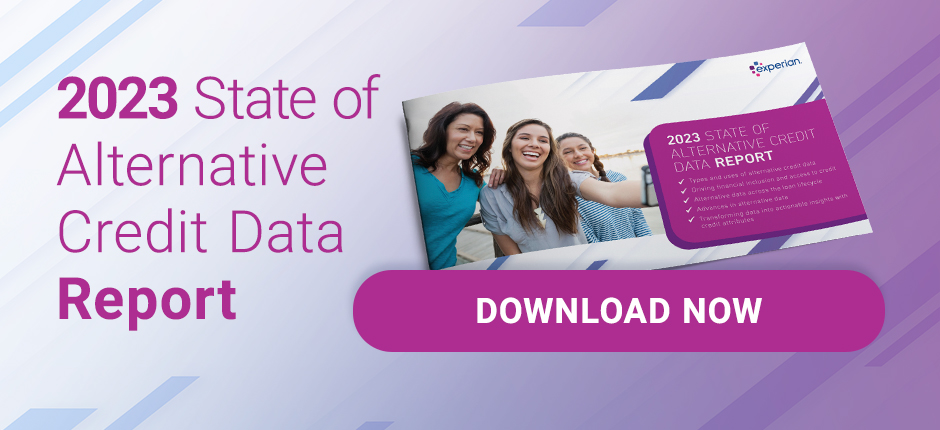Tag: alternative data

Customer retention is crucial for lenders to maximize lifetime value, especially during economic uncertainty. Increasing customer retention rates by just 5% can boost profits by 25% to 95%. However, many lenders struggle with loyalty, as seen in Q2 2024 when mortgage servicers’ retention rates for refinances dropped to 20%, the second lowest in 17 years. Nonbanks and banks also saw significant declines. This is due to increased competition, changing economic conditions, and a lack of personalization. Key strategies for improving customer retention Lenders can improve retention by leveraging data for personalization, maintaining consistent communication, offering loyalty rewards, and utilizing retention triggers. Leverage data for personalization. Use customer data to offer tailored products and refinancing options based on financial behaviors. Using credit attributes, trended data and alternative credit data (alternative financial services data, cashflow attributes, etc.) can help provide deeper insights of your customers. Maintain consistent communication. Keep customers informed with regular updates about interest rate changes or new loan products. Use a variety of communication channels, including email and in-app messaging, to ensure customers are kept in the loop. Ensure your customer service team is always available and responsive, offering clear answers to any financial concerns. Offer loyalty rewards. Develop programs that reward repeat business and referrals. Offer special rates or discounts for returning customers or for those who refer friends and family to your services. Increase customer lifetime value (LTV) by offering additional services like financial planning or credit score monitoring. Utilize retention triggers. Identify key events for engagement with automated retention triggers. For example, a borrower who has a mortgage with a fixed rate may be less likely to consider refinancing unless prompted. Experian’s Retention TriggersSM can notify lenders when refinancing might be beneficial to their customer, offering them personalized incentives or new product options at the right time. Why Experian’s Retention Triggers? By integrating Experian’s Retention Triggers, lenders can keep borrowers engaged, increase retention, and boost profitability even in tough economic times. Advanced data insights: Gain deeper insights into your customers’ behavior to identify those at risk of leaving and take proactive action. Personalized engagement: Automate personalized communications based on customer behaviors, ensuring timely engagement. Increased revenue: By offering personalized, timely and relevant offers, you can increase the likelihood of retaining your customers and growing your revenue. Make customer retention a priority In today’s challenging economic climate, lenders who focus on personalized experiences, consistent communication, and relevant offers will stand out and retain borrowers. Leverage tools like Experian’s Retention Triggers to proactively engage customers, reduce churn, and foster long-term relationships for increased profitability and success. Learn more

Gen Z, or "Zoomers," born from 1997 to 2012, are molded by modern transformations. They have witnessed events from post-9/11 impacts to the rise of the internet and the COVID-19 crisis. As early adopters of technology, their lives are intertwined with smartphones, online shopping, social platforms, cloud services, emerging fintech, and artificial intelligence. They are called “digital natives” as they are the first generation to grow up with internet as part of their daily life. Research generally indicates that this post-millennial generation values practicality, favoring financial stability over entrepreneurial pursuits. They appreciate communication tailored to them and often employ social media to cultivate their personal brands. As a generation growing up immersed in technology, they tend to choose digital interactions, seeking to forge robust, secure, genuine, and unconstrained digital experiences. The challenge of identity verification Identity verification presents a considerable challenge for Generation Z. According to a Fortune survey, close to 50% of this demographic regrets not opening financial accounts earlier, citing a lack of readiness to join the financial ecosystem by the age of 18. Consequently, this has given rise to "digital ghosts"—people with minimal or nonexistent financial histories who face challenges when trying to utilize financial services. The 2009 Credit Card Accountability Responsibility and Disclosure Act mandates that individuals under 21 need a cosigner or show income proof to get a credit card, hindering their early financial involvement. Moreover, conventional identity checks are becoming less reliable due to the surge in identity theft. Innovative solutions for verifying Gen Z Verifying identities and preventing fraud among Gen Z presents unique challenges due to their digital-native status and limited credit histories. Here are some effective strategies and approaches that financial institutions can adopt to address these challenges: Leveraging alternative data sources Academic records leverage information from higher learning institutions such as universities, colleges, and vocational schools. This data can be vital for authenticating the identities of younger individuals who may lack a substantial credit history. Employment verification retrieve data confirming the identity and employment status, especially focusing on Gen Z who are new to the job market. Utility and telecom records leverage payment histories for utilities, phone bills, and other recurring services, which can provide additional layers of identity verification. Alternative financial data includes online small dollar lenders, online installment lenders, single payment, line of credit, storefront small dollar lenders, auto title and rent-to-own. Phone-Centric ID Phone-Centric Identity refers to technology that leverages and analyzes mobile, telecom, and other signals for the purposes of identity verification, identity authentication, and fraud prevention. Phone-Centric Identity relies on billions of signals from authoritative sources pulled in real time, making it a powerful proxy for digital identity and trust. Advance authentication technologies Behavioral biometrics analyze user behaviors such as typing patterns, navigation habits, and device usage. These subtle behaviors can help create a unique profile for each user, making it difficult for fraudsters to impersonate them. Adaptive risk-based authentication that adjusts the level of security based on the user's behavior, location, device, and other factors. For example, a higher level of verification might be required for transactions that are deemed unusual or high-risk. Real-time fraud detection AI and machine learning: Deploy AI and machine learning algorithms to analyze transaction patterns and detect anomalies in real-time. These technologies can identify suspicious activities and flag potential fraud. Fraud analytics: Use predictive analytics to assess the likelihood of fraud based on historical data and current behavior. This approach helps in proactively identifying and mitigating fraudulent activities. Secure digital onboarding Digital identity verification: Implement digital onboarding processes that include online identity verification with real-time document verification. Users can upload government-issued IDs and take selfies to confirm their identity. Video KYC (Know Your Customer): Use video calls to conduct KYC processes, allowing bank representatives to verify identities and documents remotely via automated identity verification. This method is secure and convenient for tech-savvy Gen Z customers. Make identity verification easy To authenticate identities and combat fraud within the Gen Z population, financial organizations need to implement a comprehensive strategy utilizing innovative technologies, non-traditional data, and strong protective protocols. Such actions will enable the creation of a trustworthy and frictionless banking environment that appeals to a generation adept in digital interactions, thereby establishing trust and encouraging enduring connections. To learn more about Experian’s automated identity verification solutions, visit our website. Learn more

Open banking is revolutionizing the financial services industry by encouraging a shift from a closed model to one with greater transparency, competition, and innovation. But what does this mean for financial institutions, and how can you adapt to this new landscape, balancing opportunity against risk? In this article, we will define open banking, illustrate how it operates, and weigh the challenges and benefits for financial institutions. What is open banking? Open banking stands at the forefront of financial innovation, embodying a shift toward a more inclusive, transparent, and consumer-empowered system. At its core, open banking relies on a simple yet powerful premise: it uses consumer-permissioned data to create a networked banking ecosystem that benefits both financial institutions and consumers alike. By having secure, standardized access to consumer financial data — granted willingly by the customers themselves — lenders can gain incredibly accurate insights into consumer behavior, enabling them to personalize services and offers like never before. How does open banking work? Open banking is driven by Application Programming Interfaces (APIs), which are sets of protocols that allow different software components to communicate with each other and share data seamlessly and securely. In the context of open banking, these APIs enable: Account Information Services (AIS): These services allow third-party providers (TPPs) to access account information from financial institutions (with customer consent) to provide budgeting and financial planning services. Payment Initiation Services (PIS): These services permit TPPs to initiate payments on behalf of customers, often offering alternative, faster, or cheaper payment solutions compared to traditional banking methods. Financial institutions must develop and maintain robust and secure APIs that TPPs can integrate with. This requires significant investment in technology and cybersecurity to protect customer data and financial assets. There must also be clear customer consent procedures and data-sharing agreements between financial institutions and TPPs. Benefits of open banking Open banking is poised to create a wave of innovation in the financial sector. One of the most significant benefits is the ability to gain a more comprehensive view of a consumer’s financial situation. With a deeper view of consumer cashflow data and access to actionable insights, you can improve your underwriting strategy, optimize account management and make smarter decisions to safely grow your portfolio. Additionally, open banking promotes financial inclusion by enabling financial institutions to offer more tailored products that suit the needs of previously underserved or unbanked populations. This inclusivity can help bridge the gap in financial services, making them accessible to a broader segment of the population. Furthermore, open banking fosters competition among financial institutions and fintech companies, leading to the development of better products, services, and competitive pricing. This competitive environment not only benefits consumers but also challenges banks to innovate, improve their services, and operate more efficiently. The collaborative nature of open banking encourages an ecosystem where traditional banks and fintech startups co-create innovative open banking solutions. This synergy can accelerate the pace of digital transformation within the banking sector, leading to the development of cutting-edge technologies and platforms that address specific market gaps or consumer demands. Challenges of open banking While open banking presents a plethora of opportunities, its adoption is not without challenges. Financial institutions must grapple with several hurdles to fully leverage the benefits open banking offers. One of the most significant challenges is fraud detection in banking and ensuring data security and privacy. The sharing of financial data through APIs necessitates robust cybersecurity measures to protect sensitive information from breaches and fraud. Banks and TPPs alike must invest in advanced security technologies and protocols to safeguard customer data. Additionally, regulatory compliance poses a considerable challenge. Open banking regulations vary widely across different jurisdictions, requiring banks to adapt their operations to comply with diverse legal frameworks. Staying abreast of evolving regulations and ensuring compliance can be resource-intensive and complex. Furthermore, customer trust and awareness are crucial to the success of open banking. Many consumers are hesitant to share their financial data due to privacy concerns. Educating customers on the benefits of open banking and the measures taken to ensure their data’s security is essential to overcoming this obstacle. Despite these challenges, the strategic implementation of open banking can unlock remarkable opportunities for innovation, efficiency, and service enhancement in the financial sector. Banks that can successfully navigate these hurdles and capitalize on the advantages of open banking are likely to emerge as leaders in the new era of financial services. Our open banking strategy Our newly introduced open banking solution, Cashflow Attributes, powered by Experian’s proprietary data from millions of U.S. consumers, offers unrivaled categorization and valuable consumer insights. The combination of credit and cashflow data empowers lenders with a deeper understanding of consumers. Furthermore, it harnesses our advanced capabilities to categorize 99% of transaction Demand Deposit Account (DDA) and credit card data, guaranteeing dependable inputs for robust risk assessment, targeted marketing and proactive fraud detection. Watch open banking webinar Learn more about Cashflow Attributes

Over the past few decades, the financial industry has gone through significant changes. One of the most notable changes is the use of alternative credit data1 for lending. This type of data is becoming increasingly essential in consumer and small business lending. In this blog post, we’ll explore the importance of alternative credit data and the insights you can gain from our new 2023 State of Alternative Credit Data Report. Benefits and uses of alternative credit data and alternative lending Alternative credit data and alternative financial services offer substantial benefits to lenders, borrowers, and society as a whole. The primary advantage of alternative credit data is that it provides a more comprehensive and accurate credit history of the borrower. Unlike traditional credit data that focuses on a borrower’s financial past, alternative credit data includes information from non-traditional sources like rent payments, full-file public records, utility bills, and income and employment data. This additional data allows you to gain a better understanding of financial behavior and assess creditworthiness more accurately.Alternative credit data can be used throughout the loan lifecycle, from underwriting to servicing. In the underwriting phase, alternative credit data can help lenders expand their pool of potential borrowers, especially those who lack or have limited traditional credit history. Additionally, alternative credit data can help lenders identify risks and minimize fraud. In the servicing phase, alternative credit data can help lenders monitor financial health and provide relevant services and an enhanced customer experience.Alternative lending is critical for driving financial inclusion and profitability. Traditional credit models often exclude individuals who have limited or no access to credit, causing them to turn to high-cost alternatives like payday loans. Alternative credit data can provide a more accurate assessment of their ability to pay, making it easier for them to access affordable credit. This increased accessibility improves the borrower's financial health and creates new opportunities to expand your customer base. “Lenders can access credit data and real-time information about consumers’ incomes, employment statuses, and how they are managing their finances and get a more accurate view of a consumer’s financial situation than previously possible.”— Scott Brown, President of Consumer Information Services, Experian State of alternative credit data Our new 2023 State of Alternative Credit Data Report provides exclusive insight into the alternative lending market, new data sources, inclusive finance opportunities and innovations in credit attributes and scoring that are making credit scoring more accurate, transparent and inclusive. For instance, the use of machine learning algorithms and artificial intelligence is enabling lenders to develop more predictive alternative credit scoring models and enhance risk assessment. Findings from the report include: 54% of Gen Z and 52% of millennials feel more comfortable using alternative financing options rather than traditional forms of credit.2 62% of financial institution firms are using alternative data to improve risk profiling and credit decisioning capabilities.3 Modern credit scoring methods could allow lenders to grow their pool of new customers by almost 20%.4 By understanding the power of alternative credit data and staying on top of the latest industry trends, you can widen your pool of borrowers, drive financial inclusion, and grow sustainably. Download now 1When we refer to “Alternative Credit Data,” this refers to the use of alternative data and its appropriate use in consumer credit lending decisions, as regulated by the Fair Credit Reporting Act. Hence, the term “Expanded FCRA Data” may also apply in this instance and both can be used interchangeably.2Experian commissioned Atomik Research to conduct an online survey of 2,001 adults throughout the United States. Researchers controlled for demographic variables such as gender, age, geographic region, race and ethnicity in order to achieve similar demographic characteristics reported in the U.S. census. The margin of error of the overall sample is +/-2 percentage points with a confidence level of 95 percent. Fieldwork took place between August 22 and August 28, 2023. Atomik Research is a creative market research agency. 3Experian (2022). Reaching New Heights with Financial Inclusion 4Oliver Wyman (2022). Financial Inclusion and Access to Credit

Alternative credit scoring has become mainstream. Lenders that use alternative credit scores can find opportunities to expand their lending universe without taking on additional risk and more accurately assess the credit risk of traditionally scoreable consumers. Obtaining a more holistic consumer view can help lenders improve automation and efficiency throughout the customer lifecycle. What is alternative credit scoring? Alternative credit scoring models incorporate alternative credit data* that isn't typically found on consumer credit reports. These scores aren't necessarily trying to predict alternative outcomes. The goal is the same — to understand the likelihood that a borrower will miss payments in the future. What's different is the information (and sometimes the analytical techniques) that inform these predictions.Traditional credit scoring models solely consider information found in consumer credit reports. There's a lot of information there — Experian's consumer credit database has data on over 245 million consumers. But although traditional consumer data can be insightful, it doesn't necessarily give lenders a complete picture of consumers' creditworthiness. Alternative credit scores draw from additional data sources, including: Alternative financial services: Credit data from alternative financial services (AFS) can tell you about consumers' experiences with small-dollar installment loans, single-payment loans, point-of-sale financing, auto title loans and rent-to-own agreements. Buy Now Pay Later: Buy Now Pay Later (BNPL) borrowing is popular with consumers across the scoring spectrum, and lenders can use access to open BNPL loans to better assess consumers' current capacity. Rental payments: Landlords, property managers, collection companies, rent payment services and consumer-permissioned data can give lenders access to consumers' rent payment history. Full-file public records: Credit reports generally only include bankruptcy records from the previous seven to ten years. However, lenders with access to full-file public records can also learn about consumers' property deeds, address history, and professional and occupational licenses. READ: Take a deep dive into Experian's State of Alternative Credit Data report to learn more about the different types of alternative credit data and uses across the loan lifecycle. With open banking, consumers can now easily and securely share access to their banking and brokerage account data — and they're increasingly comfortable doing so. In fact, 70% would likely share their banking data for better loan rates, financial tools or personalized spending insights.Tools like Experian Boost allow consumers to add certain types of positive payment information to their Experian credit reports, including rent, utility and select streaming service payments. Some traditional scores consider these additional data points, and users have seen their FICO Score 8 from Experian boosted by an average of 13 points.1 Experian Go also allows credit invisible consumers to establish a credit report with consumer-permissioned alternative data. The benefits of using alternative credit data The primary benefit for lenders is access to new borrowers. Alternative credit scores help lenders accurately score more consumers — identifying creditworthy borrowers who might otherwise be automatically denied because they don't qualify for traditional credit scores. The increased access to credit may also align with lenders' financial inclusion goals.Lenders may additionally benefit from a more precise understanding of consumers who are scoreable. When integrated into a credit decisioning platform, the alternative scores could allow lenders to increase automation (and consumers' experiences) without taking on more credit risk. The future of alternative credit scoring Alternative credit scoring might not be an alternative for much longer, and the future looks bright for lenders who can take advantage of increased access to data, advanced analytics and computing power.Continued investment in alternative data sources and machine learning could help bring more consumers into the credit system — breaking barriers and decreasing the cost of basic lending products for millions. At the same time, lenders can further customize offers and automate their operations throughout the customer lifecycle. Partnering with Experian Small and medium-sized lenders may lack the budget or expertise to unlock the potential of alternative data on their own. Instead, lenders can turn to off-the-shelf alternative models that can offer immediate performance lifts without a heavy IT investment.Experian's Lift PlusTM score draws on industry- leading mainstream credit data and FCRA-regulated alternative credit data to provide additional consumer behavior insights. It can score 49% of mainstream credit-invisible consumers and for thin file consumers with a new trade, a 29% lift in scoreable accounts. Learn more about our alternative credit data scoring solutions. Learn more * When we refer to “Alternative Credit Data," this refers to the use of alternative data and its appropriate use in consumer credit lending decisions as regulated by the Fair Credit Reporting Act (FCRA). Hence, the term “Expanded FCRA Data" may also apply in this instance and both can be used interchangeably.1Experian (2023). Experian Boost

With consumers having more credit options than ever before, it’s imperative for lenders to get their message in front of ideal customers at the right time and place. But without clear insights into their interests, credit behaviors or financial capacity, you may risk extending preapproved credit offers to individuals who are unqualified or have already committed to another lender. To increase response rates and reduce wasted marketing spend, you must develop an effective customer targeting strategy. What makes an effective customer targeting strategy? A customer targeting strategy is only as good as the data that informs it. To create a strategy that’s truly effective, you’ll need data that’s relevant, regularly updated, and comprehensive. Alternative data and credit-based attributes allow you to identify financially stressed consumers by providing insight into their ability to pay, whether their debt or spending has increased, and their propensity to transfer balances and consolidate loans. With a more granular view of consumers’ credit behaviors over time, you can avoid high-risk accounts and focus only on targeting individuals that meet your credit criteria. While leveraging additional data sources can help you better identify creditworthy consumers, how can you improve the chances of them converting? At the end of the day, it’s also the consumer that’s making the decision to engage, and if you aren’t sending the right offer at the precise moment of interest, you may lose high-value prospects to competitors who will. To effectively target consumers who are most likely to respond to your credit offers, you must take a customer-centric approach by learning about where they’ve been, what their goals are, and how to best cater to their needs and interests. Some types of data that can help make your targeting strategy more customer-centric include: Demographic data like age, gender, occupation and marital status, give you an idea of who your customers are as individuals, allowing you to enhance your segmentation strategies. Lifestyle and interest data allow you to create more personalized credit offers by providing insight into your consumers’ hobbies and pastimes. Life event data, such as new homeowners or new parents, helps you connect with consumers who have experienced a major life event and may be receptive to event-based marketing campaigns during these milestones. Channel preference data enables you to reach consumers with the right message at the right time on their preferred channel. Target high-potential, high-value prospects By using an effective customer targeting strategy, you can identify and engage creditworthy consumers with the greatest propensity to accept your credit offer. To see if your current strategy has what it takes and what Experian can do to help, view this interactive checklist or visit us today. Review your customer targeting strategy Visit us

Even before the COVID-19 pandemic, many Americans lacked equal access to financial products and services — from tapping into affordable banking services to credit cards to financing a home purchase. The global pandemic likely exacerbated those existing issues and inequalities. That reality makes financial inclusion — a concerted effort to make financial products and services affordable and accessible to all consumers — more crucial than ever. The playing field wasn't level before the pandemic The Federal Reserve reported that in 2019, Black and Hispanic/Latino families had median wealth that was just 13 to 19 percent of that of White families — $24,100 and $36,100, respectively, compared to $188,200 for White families. That inequity is also reflected in credit score disparities. While credit scores, income, and wealth aren't synonymous, the traditional credit scoring system leads marginalized communities to be disproportionately labeled unscoreable or credit invisible, and face challenges in accessing credit. New research from Experian shows that in over 200 cities, there can be more than a 100-point difference in credit scores between neighborhoods — often within just a few miles from each other. Marginalized communities bore the financial brunt Minority communities were also disproportionately impacted by COVID-19 in terms of infections, job losses, and financial hardship. In mid-2020, the Economic Policy Institute (EPI) reported Black and Hispanic/Latino workers were more likely than White workers to have lost their jobs or to be classified as essential workers — leading to economic or health insecurity. Government initiatives — including the Coronavirus Aid, Relief, and Economic Security (CARES) Act, the Paycheck Protection Program (PPP) and the American Rescue Plan — created expanded unemployment benefits, paused loan payments, eviction moratoriums, and direct cash payments. These helped consumers' immediate financial well-being. The National Bureau of Economic Research found that, on average, U.S. households spent approximately 40 percent of their first two stimulus checks, with about 30 percent used for savings and another 30 percent used to pay down debt. In some communities highly affected by COVID-19, consumers were able to pay down nearly 40 percent of their credit card balances and close more than 9 percent of their bank card accounts, according to recent data. Stimulus payments have been credited with reducing childhood poverty and helping families save for financial emergencies. That being said, people on the upper end of the income scale were able to improve their financial situation even more. Their wealth grew at a much faster pace than people at the bottom end of the income distribution scale, according to data from the Federal Reserve. How the pandemic deepened financial exclusion Although hiring has picked up in low-wage industries, research indicates that low-wage jobs have been the slowest to return. According to a survey by the Pew Research Center, among respondents who said their financial situation worsened during the pandemic, 44 percent believe it will take three years or more to get back to where they were a year ago. About 10 percent don't think their finances will ever recover. Recent Experian data shows that consumers in certain communities that were already struggling to pay their debts fell into an even bigger hole. These consumers missed payments on 56 percent more accounts in the period between spring 2019 to spring 2020 compared to the year prior. Credit scores in these neighborhoods fell by an average of over 20 points during the first 18 months of COVID-19. That being said, U.S. consumers overall increased their median credit scores by an average of 21 points from the end of 2019 to the end of 2021. When consumers with deteriorating credit encounter financial stresses, often their only recourse is to pile on additional debt. Even worse, those who can't access traditional credit often turn to alternative credit arrangements, such as short-term loans, which may charge significantly higher interest rates. READ MORE: More Than a Score: The Case for Financial Inclusion What can the financial sector do? Without access to affordable financial services and products, subprime or credit invisible consumers may not get approved for a mortgage or car loan — things that might come much easier for consumers with better scores. This is just one reason why financial inclusion is so important — and why financial services companies have a big role to play in driving it. One place to start is by taking a broader view of what makes a creditworthy consumer. In addition to traditional credit scoring models, new tools can leverage artificial intelligence and machine learning, along with alternative data, to analyze the creditworthiness of consumers. By qualifying for credit, more consumers can access affordable mortgages, car loans, business loans and insurance - freeing up money for other expenses and allowing them to grow their wealth.. READ MORE: What Is Alternative and Non-Traditional Data? Last word Marginalized communities were already struggling economically before the pandemic, and the impact of COVID-19 has made the wealth disparities worse. With the pandemic waning, now is the time for financial institutions to take action on financial inclusion. Not only does it help improve your customers' lives and make them better prepared for the next crisis, but it also fuels your business's growth and bottom line.

Credit reports and conventional credit scores give lenders a strong starting point for evaluating applicants and managing risk. But today's competitive environment often requires deeper insights, such as credit attributes. Experian develops industry-leading credit attributes and models using traditional methods, as well as the latest techniques in machine learning, advanced analytics and alternative credit data — or expanded Fair Credit Reporting Act (FCRA)-regulated data)1 to unlock valuable consumer spending and payment information so businesses can drive better outcomes, optimize risk management and better serve consumers READ MORE: Using Alternative Credit Data for Credit Underwriting Turning credit data into digestible credit attributes Lenders rely on credit attributes — specific characteristics or variables based on the underlying data — to better understand the potentially overwhelming flow of data from traditional and non-traditional sources. However, choosing, testing, monitoring, maintaining and updating attributes can be a time- and resource-intensive process. Experian has over 45 years of experience with data analytics, modeling and helping clients develop and manage credit attributes and risk management. Currently, we offer over 4,500 attributes to lenders, including core attributes and subsets for specific industries. These are continually monitored, and new attributes are released based on consumer trends and regulatory requirements. Lenders can use these credit attributes to develop precise and explainable scoring models and strategies. As a result, they can more consistently identify qualified prospects that might otherwise be missed, set initial limits, manage credit lines, improve loyalty by applying appropriate treatments and limit credit losses. Using expanded credit data effectively Leveraging credit attributes is critical for portfolio growth, and businesses can use their expanding access to credit data and insights to improve their credit decisioning. A few examples: Spot trends in consumer behavior: Going beyond a snapshot of a credit report, Trended 3DTM attributes reveal and make it easier to understand customers' behavioral patterns. Use these insights to determine when a customer will likely revolve, transact, transfer a balance or fall into distress. Dig deeper into credit data: Making sense of vast amounts of credit report data can be difficult, but Premier AttributesSM aggregates and summarizes findings. Lenders use the 2,100-plus attributes to segment populations and define policy rules. From prospecting to collections, businesses can save time and make more informed decisions across the customer lifecycle. Get a clear and complete picture: Businesses may be able to more accurately assess and approve applicants, simply by incorporating attributes overlooked by traditional credit bureau reports into their decisioning process. Clear View AttributesTM uses data from the largest alternative financial services specialty bureau, Clarity Services, to show how customers have used non-traditional lenders, including auto title lenders, rent-to-own and small-dollar credit lenders. The additional credit attributes and analysis help lenders make more strategic approval and credit limit decisions, leading to increased customer loyalty, reduced risk and business growth. Additionally, many organizations find that using credit attributes and customized strategies can be important for measuring and reaching financial inclusion goals. Many consumers have a thin credit file (fewer than five credit accounts), don’t have a credit file or don’t have information for conventional scoring models to score them. Expanded credit data and attributes can help lenders accurately evaluate many of these consumers and remove barriers that keep them from accessing mainstream financial services. There's no time to wait Businesses can expand their customer base while reducing risk by looking beyond traditional credit bureau data and scores. Download our latest e-book on credit attributes to learn more about what Experian offers and how we can help you stay ahead of the competition. Download e-book Learn more 1When we refer to “Alternative Credit Data," this refers to the use of alternative data and its appropriate use in consumer credit lending decisions, as regulated by the Fair Credit Reporting Act. Hence, the term “Expanded FCRA Data" may also apply in this instance and both can be used interchangeably.

From awarding bonus points on food delivery purchases to incorporating social media into their marketing efforts, credit card issuers have leveled up their acquisition strategies to attract and resonate with today’s consumers. But as appealing as these rewards may seem, many consumers are choosing not to own a credit card because of their inability to qualify for one. As card issuers go head-to-head in the battle to reach and connect with new consumers, they must implement more inclusive lending strategies to not only extend credit to underserved communities, but also grow their customer base. Here’s how card issuers can stay ahead: Reach: Look beyond the traditional credit scoring system With limited or no credit history, credit invisibles are often overlooked by lenders who rely solely on traditional credit information to determine applicants’ creditworthiness. This makes it difficult for credit invisibles to obtain financial products and services such as a credit card. However, not all credit invisibles are high-risk consumers and not every activity that could demonstrate their financial stability is captured by traditional data and scores. To better evaluate an applicant’s creditworthiness, lenders can leverage expanded data sources, such as an individual’s cash flow or bank account activity, as an additional lens into their financial health. With deeper insights into consumers’ banking behaviors, card issuers can more accurately assess their ability to pay and help historically disadvantaged populations increase their chances of approval. Not only will this empower underserved consumers to achieve their financial goals, but it provides card issuers with an opportunity to expand their customer base and improve profitability. Connect: Become a financial educator and advocate Credit card issuers looking to build lifelong relationships with new-to-credit consumers can do so by becoming their financial educator and mentor. Many new-to-credit consumers, such as Generation Z, are anxious about their finances but are interested in becoming financially literate. To help increase their credit understanding, card issuers can provide consumers with credit education tools and resources, such as infographics or ‘how-to’ guides, in their marketing campaigns. By learning about the basics and importance of credit, including what a credit score is and how to improve it, consumers can make smarter financial decisions, boost their creditworthiness, and stay loyal to the brand as they navigate their financial journeys. Accessing credit is a huge obstacle for consumers with limited or no credit history, but it doesn’t have to be. By leveraging expanded data sources and offering credit education to consumers, credit card issuers can approve more creditworthy applicants and unlock barriers to financial well-being. Visit us to learn about how Experian is helping businesses grow their portfolios and drive financial inclusion. Visit us

Many financial institutions have made inclusion a strategic priority to expand their reach and help more U.S. consumers access affordable financial services. To drive deeper understanding, Experian commissioned Forrester to do new research to identify key focal points for firms and how they are moving the needle. The study found that more than two-thirds of institutions had a strategy created and implemented while one-quarter reported they are already up and running with their inclusion plans.1 Tapping into the underserved The research examines the importance of engaging new audiences such as those that are new to credit, lower-income, thin file, unbanked and underbanked as well as small businesses. To tap into these areas, the study outlines the need to develop new products and services, adopt willingness to change policies and processes, and use more data to drive better decisions and reach.2 Expanded data for improved risk decisioning The research underlines the use of alternative data and emerging technologies to expand reach to new audiences and assist many who have been underserved. In fact, sixty-two percent of financial institutions surveyed reported they currently use or are planning to use expanded data to improve risk profiling and credit decisions, with focus on: Banking data Cash flow data Employment verification data Asset, investments, and wealth management data Alternative financial services data Telcom and utility data3 Join us to learn more at our free webinar “Reaching New Heights Together with Financial Inclusion” where detailed research and related tools will be shared featuring Forrester’s principal analyst on Tuesday, May 24 from 10 – 11 a.m. PT. Register here for more information. Find more financial inclusion resources at www.experian.com/inclusionforward. Register for webinar Visit us 1 Based on Forrester research 2 Ibid. 3 Ibid.

“Disruption has caused enormous amounts of innovation,” said Jennifer Schulz, CEO of Experian, North America. “We must continue to be the disruptors in our industry which takes effort, data, technology, bright minds and vision for what the future will be.” Schulz kicked off the 39th Vision conference with a future-focused keynote delivered to a crowd of more than 400 attendees. Alex Lintner, Group President, Experian Consumer Information Services, talked about the next phase of great, highlighting the digital transformation that has taken place in the generations of the past and the disruption and innovation happening today and in the future. Keynote speaker: Dr. Mohamed A. El-Erian Dr. Mohamed A. El-Erian, renowned economist and author, President of Queens’ College, Cambridge, Chief Economic Advisor at Allianz, Chair of President Obama’s Global Development Council and Former CEO and Co-Chief Investment Officer of PIMCO, spoke about the Fed, inflation, negative interest rates and the labor market, as well as the importance of inclusion. El-Erian, who said he reads the Financial Times religiously, acknowledged that we will make mistakes on the journey as we work to be even more inclusive. To navigate what’s ahead, he said we will need resilience, optionality and agility. “It’s important to connect with information, acknowledge the insecurity, in a language people understand, in order to connect,” he said. Session highlights – day 1 The conference hall was buzzing with conversations, discussions and thought leadership. Buy Now Pay Later A large audience was in attendance for a session that introduced Experian’s Buy Now Pay Later Bureau™ and explored how it’s the first and only solution of its kind — serving consumers, BNPL providers, financial institutions and regulators. Identity Identity is constantly evolving, and while biometrics and authentication may have become ubiquitous, there is much activity around the concepts of eIDs, identity wallets and identity networks. Experian is making identities personal and helping businesses to recognize, manage and connect customer identities in new ways using data, analytics and technology. Marketing In today’s hypercompetitive world, businesses need to engage the freshest data and increase velocity when it comes to time to market. An average of 120 days won’t cut it. Ascend Marketing speeds time to market and helps achieve higher ROI. Regulatory Landscape With so much happening at Capitol Hill, a panel of experts from DC discussed a number of topics and proposals (and their impacts), including the defense for risk-based pricing, the impact of suppressing negative data, and trending topics like Buy Now Pay Later and data portability. All the while, the tech showcase had a constant flow of attendees with demos ranging from data and decisioning to financial inclusion and technology. This is just the beginning. And as Schulz said, “There’s more to do.” More insights from Vision to come. Follow @ExperianVision to see more of the action.

For decades, the credit scoring system has relied on traditional data that only examines existing credit captured on a credit report – such as credit utilization ratio or payment history – to calculate credit scores. But there's a problem with that approach: it leaves out a lot of consumer activity. Indeed, research shows that an estimated 28 million U.S. adults are “credit invisible," while another 21 million are “unscorable."1 But times are changing. While conventional credit scoring systems cannot generate a score for 19 percent of American adults,1 many lenders are proactively turning to expanded FCRA-regulated data – or "alternative data" – for solutions. Types of expanded FCRA-regulated data By tapping into technology, lenders can access expanded FCRA-regulated data, which offers a powerful and complete view of consumers' financial situations. Expanded public record data This can include professional and occupational licenses, property deeds and address history – a step beyond the limited public records information found in standard credit reports. Such expanded public record data is available through consumer reporting agencies and does not require the customer's permission to use it since it's a public record.1 “Experian has partnerships with these agencies and can access public records that provide insight into factors like income and housing stability, which have a direct correlation with how they'll perform," said Greg Wright, Chief Product Officer for Experian Consumer Information Services. “For example, lenders can see if a consumer's professional license is in good standing, which is a strong correlation to income stability and the ability to pay back a loan." Rental payment data Experian RentBureau draws updated rental payment history data every 24 hours from property managers, electronic rent payment services and collection companies. It can also track the frequency of address changes. “Such information can be a good indicator of risk," said Wright. “It allows lenders to make informed judgments about the financial health and positive payment history of consumers." Consumer-permissioned data With permission from consumers, lenders can look at different types of financial transactions to assess creditworthiness. Experian Boost™, for example, enables consumers to factor positive payment history, such as utilities, cell phone or even streaming services, into an Experian credit file. “Using the Experian Boost is free, and for most users, it instantly improves their credit scores," said Wright. “Overall, those 'boosted' credit scores allow for fairer decisioning and better terms from lenders – which gives customers a second chance or opportunity to receive better terms." Financial Management Insights Financial Management Insights considers data that is not captured by the traditional credit report such as cash flow and account transactions. For instance, this could include demand deposit account (DDA) data, like recurring payroll deposits, or prepaid account transactions. “Examining bank account transaction data, prepaid accounts, and cash flow data can be a good indicator of ability to pay as it helps verify income, which gives lenders insights into consumers' cash flow and ability to pay," Wright added. Clarity Credit Data With Experian's Clarity Credit Data, lenders can see how consumers use expanded FCRA-regulated data along with their related payment behavior. It provides visibility into critical non-traditional loan information, including more insights into thin-file and no-file segments allowing for a more comprehensive view of a consumer's credit history. Lift Premium™ By using multiple sources of expanded FCRA-regulated data to feed composite scores, along with artificial intelligence and machine learning, Lift Premium™ can vastly increase the number of consumers who can be scored. For example, research shows that Lift Premium™ can score 96 percent of American adults – a significant increase from the 81 percent that are scorable with conventional scores relying on only traditional credit data. Additionally, such enhanced composite scores could enable 6 million of today's subprime population to qualify for “mainstream" (prime or near-prime) credit.1 How is expanded FCRA-regulated data changing the credit scoring system? The current credit scoring system is rapidly evolving, and modern technology is making it easier for lenders to access expanded FCRA-regulated data. Indeed, this data disruption is changing lender business in a positive way. “When lenders use expanded credit data assets, they see that many unscorable and credit invisible consumers are in fact creditworthy," said Wright. “Layering in expanded FCRA-regulated data gives a clearer picture of consumers' financial situation." By expanding data assets, tapping into artificial intelligence and machine learning, lenders can now score many more consumers quickly and accurately. Moreover, forward-thinking lenders see these expanded data assets as offering a competitive edge: it's estimated that modern credit scoring methods could allow lenders to grow their pool of new customers by almost 20 percent.1 Case study: Consumer-permissioned data To date, over 9 million people have used Experian Boost. The technology uses positive payment history as a way to recognize customers who exhibit strong credit behaviors outside of traditional credit products. “Boosted" consumers were able to add on average 14 points to their FICO scores in 2022 so far, making many eligible for additional financial products with better terms or better product offerings. Active Boost consumers, post new origination performed on par or better than the average U.S. originator, consistently over time. “In other words, having this additional lens into a consumer's financial health means lenders can expand their customer base without taking on additional credit risk," explains Wright. The bottom line The world of credit data is undergoing a revolution, and forward-thinking lenders can build a sound business strategy by extending credit to consumers previously excluded from it. This not only creates a more equitable system, but also expands the customer base for proactive lenders who see its potential in growing business. Learn more 1Oliver Wyman white paper, “Financial Inclusion and Access to Credit,” January 12, 2022.

Millions of consumers are excluded from the credit economy, whether it’s because they have limited credit history, dated information within their credit file, or are a part of a historically disadvantaged group. Without credit, it can be difficult for consumers to access the tools and services they need to achieve their financial goals. This February, Experian surveyed over 1,000 consumers across census demographics, including income, ethnicity, and age, to understand the perceptions, needs, and barriers underserved communities face along their credit journey. Our research found that: 75% of consumers with an average household income of less than $50,000 have less than $1,000 in savings. 1 in 5 consumers with an average household income of less than $35,000 say they’re confident in getting approved for credit. 80% of respondents who are not or slightly confident in getting approved for credit were women. When asked why they believed they would not get approved for credit, participants shared common responses, such as having poor payment history, a low credit score, and insufficient income. Given these findings, what can lenders provide to help underserved consumers strengthen their financial profiles and gain access to the credit they need and deserve? The power of credit education While only 20% of respondents were familiar with credit education tools, the majority expressed interest in these offerings. With Experian, lenders can develop and implement credit education programs, tools, and solutions to help consumers understand their credit and the impact certain choices can have on their credit scores. From interactive tools like Score Simulator and Score Planner to real-time alerts from Credit Monitoring, consumers can actively assess their financial health, take steps to improve their creditworthiness, and ultimately become better candidates for credit offers. In turn, consumers can feel more confident and empowered to achieve their financial goals. Credit education tools not only help consumers increase their credit literacy, confidence, and chances of approval, but they also create opportunities for lenders to build lasting customer relationships. Consumers recognize that healthy credit plays an important role in their financial lives, and by helping them navigate the credit landscape, lenders can increase engagement, build loyalty, and enhance their brand’s reputation as an organization that cares about their customers. Empowering consumers with credit education is also a way for lenders to unlock new revenue streams. By learning to borrow, save, and spend responsibly, consumers can improve their creditworthiness and be in a better position to accept extended credit offerings, driving more cross-sell and upsell opportunities for lenders. More ways experian can help Experian is deeply committed to helping marginalized and low-income communities access the financial resources they need. In addition to our credit education tools, here are a few of our other offerings: Our expanded data helps lenders make better lending decisions by providing greater visibility and transparency around a consumer’s inquiry and payment behaviors. With a holistic view of their current and prospective customers, lenders can more accurately identify creditworthy applicants, uncover new growth opportunities, and expand access to credit for underserved consumers. Experian GoTM is a free, first-of-its-kind program to help credit invisibles and those with limited credit histories begin building credit on their own terms. After authenticating their identities and obtaining an Experian credit report, users will receive ongoing education about how credit works and recommendations to further build their credit history. To learn more about building profitable customer relationships with credit education, check out our credit education solutions and watch our Three Ways to Uncover Financial Growth Opportunities that Benefit Underserved Communities webinar. Learn more Watch webinar

As more consumers apply for credit and increase their spending1, lenders and financial institutions have an opportunity to expand their portfolios and improve profitability. The challenge is ensuring they’re extending credit responsibly and inclusively. Millions of Americans, many of whom are creditworthy, lack access to mainstream credit options. This may be because they have limited or no credit history, negative information within their credit file, or are a part of a historically disadvantaged group. To say “yes” to consumers they otherwise couldn’t or wouldn’t lend to, lenders must gain a deeper understanding of an individual’s stability, ability and willingness to pay. That’s where expanded FCRA-regulated and trended data come in. While traditional credit data has long been the primary means of gauging creditworthiness, it doesn’t tell the full story of a consumer’s financial situation. Let’s explore how differentiated data can help lenders make more informed credit decisions. Using differentiated data for deeper lending Expanded FCRA-regulated data provides supplemental credit data to help lenders gain a more holistic view of their current and prospective customers. Some examples of expanded FCRA-regulated data include alternative financial services data from nontraditional lenders, consumer-permissioned account data, rental payments and full-file public records. Because this data drives greater visibility and transparency around inquiry and payment behaviors, lenders can more accurately determine a consumer’s ability to pay and distinguish between reliable and high-risk applicants. In turn, lenders can approve more creditworthy consumers, grow their portfolios and increase financial opportunities for underserved communities, all while preventing and mitigating risk. 89% of lenders agree that expanded FCRA-regulated data allows them to extend credit to more consumers. Trended data empowers lenders with predictive insights into consumers by providing key balance and payment data for the previous 24 months. This is important as lenders can determine if a consumer’s credit behavior has improved or deteriorated over time. In turn, lenders can: Identify creditworthy customers: Establish if a consumer has a demonstrated ability to pay, is consistently paying more than the minimum payment, or shows no signs of payment stress. Increase response rates: Match the right products with the right prospects. Determine upsell and cross-sell opportunities: Present relevant offers based on anticipated needs and behaviors. Limit loss exposure: Understand the direction and velocity of payment performance to effectively manage risk exposure. Trended data helps lenders better predict future behavior, manage portfolio risk and design the best marketing offers. Turning insights into action Together, trended and expanded FCRA-regulated data benefit lenders and consumers alike. With a more holistic view of their customers, lenders gain powerful insights to lend deeper, ultimately helping them to expand their portfolios and drive greater access to credit for underserved communities. Learn more 1 The Recovery of Credit Applications to Pre-Pandemic Levels, Consumer Financial Protection Bureau, 2021.

Lenders are under pressure to improve access to financial services, but can it also be a vehicle for driving growth? With the global pandemic and social justice movements exposing societal issues of equity, financial institutions are being called upon to do their part to address these problems, too. Lenders are increasingly under pressure to improve access to the financial system and help close the wealth gap in America. Specifically, there are calls to improve financial inclusion – the process of ensuring financial products and services are accessible and affordable to everyone. Financial inclusion seeks to remove barriers to accessing credit, which can ultimately help individuals and businesses create wealth and elevate communities. Activists and regulators have singled out the current credit scoring system as a significant obstacle for a large portion of U.S. consumers. From an equity standpoint, tackling financial inclusion is a no-brainer: better access to credit allows more consumers to secure safer housing and better schools, which could lead to higher-paying jobs, as well as the ability to start businesses and get insurance. Being able to access credit in a regulated and transparent way underpins financial stability and prosperity for communities and is key to creating a stronger economic system. Beyond “doing the right thing," research shows that financial inclusion can also fuel business growth for lenders. Get ahead of the game There is mounting regulatory pressure to embrace financial inclusion, and financial institutions may soon need to comply with new mandates. Current lending practices overlook many marginalized communities and low-income consumers, and government agencies are seeking to change that. Government agencies and organizations, such as the Consumer Financial Protection Bureau (CFPB) and Office of the Comptroller of the Currency (OCC), are requiring greater scrutiny and accountability of financial institutions, working to overhaul the credit reporting system to ensure fairness and equality. As a lender, it makes good business sense to tackle this problem now. For starters, as more institutions embrace Corporate Social Responsibility (CSR) mandates—something that's increasingly demanded by shareholders and customers alike—financial inclusion is a natural place to start. It demonstrates a commitment to CSR principles and creates a positive brand built on equity. Further, financial institutions that embrace these changes gain an early adopter advantage and can build a loyal customer base. As these consumers begin to build wealth and expand their use of financial products, lenders will be able to forge lifelong relationships with these customers. Why not get a head start on making positive organizational change before the law compels it? Grow your business (and profits) To be sure, financial inclusion is a pressing moral imperative that financial institutions must address. But financial inclusion doesn't come at the expense of profit. It represents an enormous opportunity to do business with a large, untapped market without taking on additional risk. In many instances, unscorable and credit invisible consumers exhibit promising credit characteristics, which the conventional credit scoring system does not yet recognize. Consider consumers coming to the U.S. from other countries. They may have good credit histories in their home countries but have not yet established a credit history here. Likewise, many young, emerging consumers haven't generated enough history to be categorized as creditworthy. And some consumers may simply not utilize traditional credit instruments, like credit cards or loans. Instead, they may be using non-bank credit instruments (like payday loans or buy-now-pay-later arrangements) but regularly make payments. Ultimately, because of the way the credit system works, research shows that lenders are ignoring almost 20 percent of the U.S. population that don't have conventional credit scores as potential customers. These consumers may not be inherently riskier than scored consumers, but they often get labelled as such by the current credit scoring system. That's a major, missed opportunity! Modern credit scoring tools can help fill the information gap and rectify this. They draw on wider data sources that include consumer activities (like rent, utility and non-bank loan payments) and provide holistic information to assist with more accurate decisioning. For example, Lift Premium™ can score 96 percent of Americans with this additional information—a vast improvement over the 81 percent who are currently scored with conventional credit data.1 By tapping into these tools, financial institutions can extend credit to underserved populations, foster consumer loyalty and grow their portfolio of profitable customers. Do good for the economy Research suggests that financial inclusion can provide better outcomes for both individuals and economies. Specifically, it can lead to greater investment in education and businesses, better health, lower inequality, and greater entrepreneurship. For example, an entrepreneur who can access a small business loan due to an expanded credit scoring model is subsequently able to create jobs and generate taxable revenue. Small business owners spend money in their communities and add to the tax base – money that can be used to improve services and attract even more investment. Of course, not every start-up is a success. But if even a portion of new businesses thrive, a system that allows more consumers to access opportunities to launch businesses will increase that possibility. The last word Financial inclusion promotes a stronger economy and thriving communities by opening the world of financial services to more people, which benefits everyone. It enables underserved populations to leverage credit to become homeowners, start businesses and use credit responsibly—all markers of financial health. That in turn creates generational wealth that goes a long way toward closing the wealth gap. And widening the credit net also enables lenders to uncover new revenue sources by tapping new creditworthy consumers. Expanded data and advanced analytics allow lenders to get a fuller picture of credit invisible and unscorable consumers. Opening the door of credit will go a long way to establishing customer loyalty and creating opportunities for both consumers and lenders. Learn more